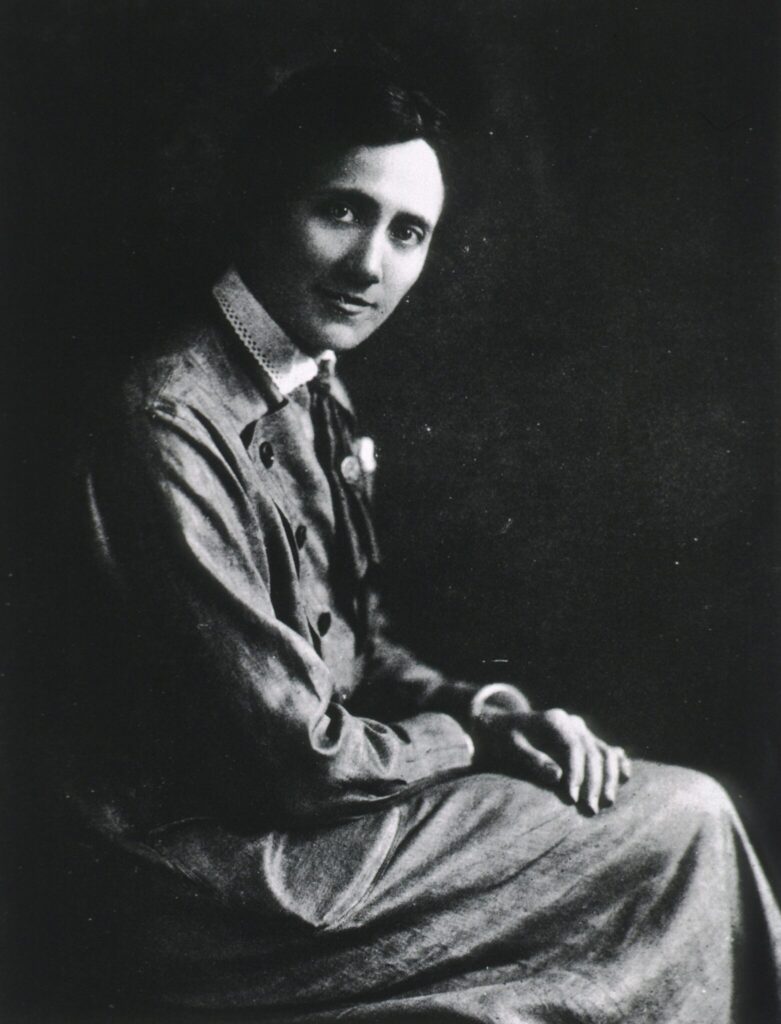
This biographical sketch first appeared on the Online Biographical Dictionary of the Woman Suffrage Movement in the United States and appears here by courtesy of the publisher, Alexander Street.
By Priya Hay-Chatterjee, undergraduate student, University of Maryland, College Park
Public Health Nurse, Suffragist, and Collector of Antiques
Mary Elizabeth Lent was born in upstate New York near Rochester on October 24, 1869. Her father was born in New Jersey; her mother, in Vermont.
In 1895, Mary Lent graduated from Johns Hopkins Nursing School in Baltimore, Maryland, and she began her career as a head nurse at Hopkins University Hospital, and in 1903, she was promoted to superintendent of the Instructive Visiting Nurse Association of Baltimore. Lent advocated for workers’ health, especially women, advising these industrial women to sleep with windows open to get fresh air during the hours they were away from work. She published her research findings from nursing patients with tuberculosis and other diseases in various medical journals, including the British Journal of Nursing, the Maryland Medical Journal, the American Journal of Nursing, the Pacific Coast Journal of Nursing, Public Health Nursing Quarterly, and Public Health Nurse.
Besides her career in nursing, Lent advocated for women’s suffrage. The Just Government League of Maryland was a precursor to the Woman Suffrage League of Maryland, the former being founded in 1910 by Edith Houghton Hooker and presided over by Mary Lent, who served through 1912. As president, Lent gave a speech to hundreds of nurses. After the speech, 300 of those nurses signified that they would support the suffrage bill for which she advocated. The Just Government League was affiliated with the National American Woman Suffrage Association until the Woman Suffrage League took its place around 1917-1918. Also in 1910, Lent spoke before the Maryland House of Delegates with the Equal Suffrage League of Baltimore in support of a bill that would have enfranchised all residents of Baltimore in city elections only, so long as they were 21 years of age and qualified to vote for a member of the House of Delegates or, if not so qualified, were either able to read or write five lines of the Maryland state Constitution or owned property valued at least $300 and had paid taxes on this property for at least two years. A petition for the bill won 173,000 signatures but was controversial, as it offered suffrage only to literate or property-owning women in municipal elections of Baltimore. The bill passed in the House of Delegates but not the Senate. Most suffragists in Maryland opposed this bill in favor of another, which aimed to grant full suffrage to all adult women in the state. This bill did not pass either.
Beginning in 1917, Lent traveled the country as general supervising nurse for the U.S. Public Health Service, inspecting the sanitary condition of areas where large concentrations of troops and their families were stationed during World War I. During her two years in this position, she organized 37 zones of nursing activity and directed a staff of over 200 nurses. She resigned in 1919. Lent was active in other initiatives as well. She was an associate secretary for the National Organization for Public Health Nursing and helped raise endowment funds for the Johns Hopkins School of Nursing. Before retiring from nursing, Lent began a program with the Public Athletic League of Baltimore, which provided health screenings for Baltimore athletes. In 1922, Lent retired from nursing.
In retirement, Mary E. Lent opened an antique shop in New York, returning to the region of her childhood. She died in Wallington, New York, on November 11, 1946.
SOURCES:
“Chief Nurse Dies.” Dunkirk Evening Observer (Dunkirk, NY). November 13, 1946, p.2. Newspapers.com.
Harper, Ida Husted, ed. “Maryland,” chapter XIX in History of Woman Suffrage, vol. 6: 1900-1920. New York: National American Woman Suffrage Association, 1922, pp. 258-76. [LINK]
Lent, Mary E. and Ellen N. La Motte. “The Present Status of Tuberculosis Work among the Poor.” Maryland Medical Journal 52 (April 1909): 147-60.
“Lyons Club Waits Talk on Canals.” Democrat and Chronicle (Rochester, NY). November 14, 1939, p.7. Newspapers.com.
“Medical Items.” Maryland Medical Journal 56, no. 2 (February 1913): 52. GoogleBooks.
“Nurses Become Suffragists: Three Hundred Converted to Cause by Two Speeches.” Baltimore Sun (Baltimore, MD).February 12, 1910, p.7. ProQuest Historical Newspapers.
“Pleasure Pure and Simple.” Baltimore Sun (Baltimore, MD.) May 4, 1911, p.7. Newspapers.com.
Sentz, Lilli. “Mary E. Lent.” In American Nursing: A Biographical Dictionary. Edited by Vern L. Bullough, Olga Maranjian Church, and Alice P Stein. New York: Garland Publishing, 1988, 211-12. Internet Archive.
United States Census 1900, 1910, s.v. “Mary E. Lent, Baltimore, MD.” HeritageQuest.
Warren, Mame. Our Shared Legacy: Nursing Education at Johns Hopkins, 1889-2006. Baltimore: Johns Hopkins University Press, 2006, p.41.
“Women for the Ballot.” Baltimore Sun (Baltimore, MD). December 6, 1909, p.14. ProQuest Historical Newspapers.
“Work of Mary E. Lent.” Democrat and Chronicle (Rochester, NY). December 8, 1915, p.11. Newspapers.com.

